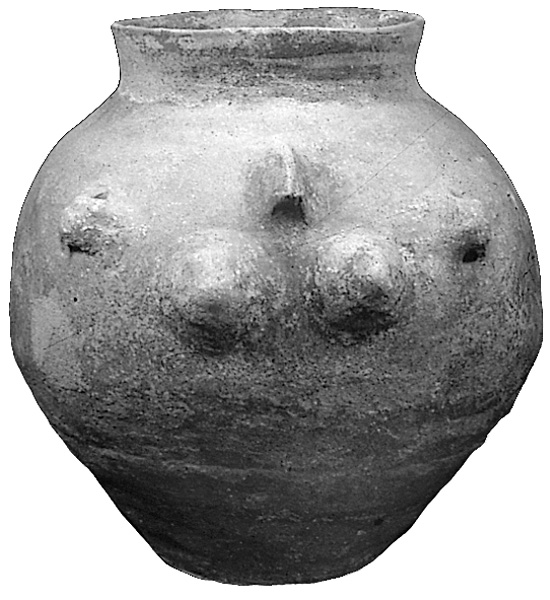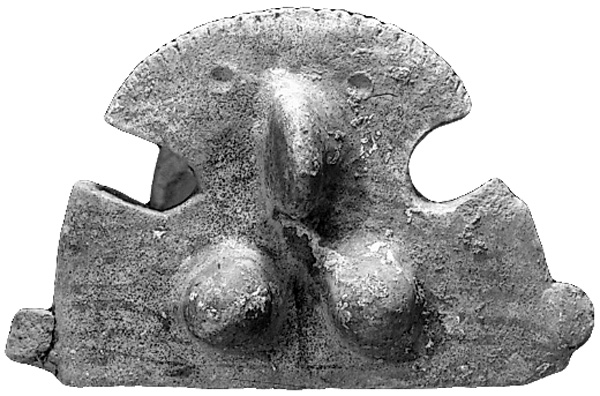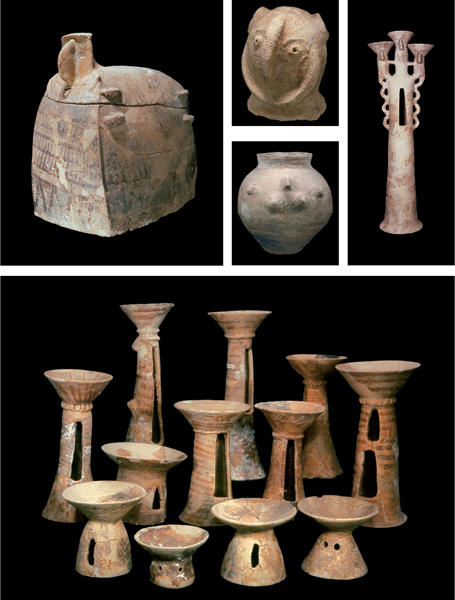Peqi‘in Cave
INTRODUCTION
During the course of road construction near Peqi‘in in Upper Galilee, a unique Chalcolithic burial cave was revealed in 1995 on the eastern face of a hill sloping down to the Peqi‘in Valley. A salvage excavation was conducted the same year by Z. Gal, H. Smithline, and D. Shalem on behalf of the Israel Antiquities Authority.
The Peqi‘in cave appears to have been a central mortuary site at which ancestor worship was practiced during the Chalcolithic period. Most of the finds from the cave, apart from sculpted heads and new types of ossuaries, are familiar from other sites of the period. However, it marks the first instance in which all the regional Chalcolithic sub-cultures are found in a single defined context, thus providing a unique opportunity to study the interrelations among these regions.
EXCAVATION RESULTS
THE CAVE. The cave, 17 m long and 5–7 m wide, consists of three spaces at distinct levels. These spaces slope downward toward the interior of the cave from east to west. An impenetrable corridor, full of debris, led from the cave entrance to the uppermost level. The eastern part of this space, leveled and partially paved with fieldstone, was buried under debris and ceiling collapse. Ossuaries stood upon the fieldstone surface, crushed by the collapse. A built stone platform upon which ossuaries were also found is situated at the southern side of this uppermost level. On its western side is a terrace wall dividing it from the intermediate level. A niche in the northern wall of the cave was filled with a large quantity of disarticulated human bones, apparently randomly dumped.
The intermediate level slopes sharply downward toward the interior of the cave, with a 2-m difference in height between its upper and lower ends. In this spot also ossuaries and burial jars were found upon stone-built terraces that created level surfaces. At the lowest part of this level is another low terrace wall.

West of that wall lies the lowest, innermost level of the cave, also the largest in area. In the southern and northern corners are stone-built platforms separated by large boulders which had fallen from the walls. A variety of objects were found on these platforms, mostly ossuaries and jars, some of which had calcified as a result of karstic activity. Above the southwestern end of this unit, 2 m higher than the floor, is a loft-like area which was also utilized for ossuary and jar burials. This area was the most affected by geological activity at the site and was almost totally covered by flowstone, stalagmites, and stalactites.
The cave had two main phases of use. In the pre-Ghassulian phase, it apparently served as a seasonal dwelling. The pottery assemblage from this phase includes typical early Chalcolithic period vessels: jars with bow rims, hole-mouth jars, and V-shaped bowls. In the Ghassulian phase, from which most of the finds originate, the cave was transformed into a burial place. Shortly after the final burial, but still within the Chalcolithic period, the cave was extensively robbed, leaving most of the objects in total disarray. Following the robbery, karstic activity increased, producing hundreds of stalactites and stalagmites, which covered ossuaries, burial jars, bones, and other objects, forming petrified masses of archaeological accumulations.

THE FINDS. Ossuaries. A variety of ossuary types was found, the majority comprising rectangular boxes with flat bases, sometimes with four or six legs, and a separate gabled lid. The box and lid were made as a single unit and subsequently separated by a string while leather hard. A series of small horizontal handles was placed symmetrically on the boxes and lids to facilitate their being tied together. The façades of the lids comprise flat plaques depicting symbolic faces, all painted with applied human facial features or three-dimensionally sculpted human heads. Another common ossuary type consists of a closed box with four or six legs, an opening at the rear to allow the insertion of bones, and a façade with prominent nose and eyes, either sculpted or painted. This type of ossuary is common to sites of the Coastal Plain, of which

Jars. Secondary burial in jars was also practiced at Peqi‘in. Most of the jars have large pierced handles and similar small handles for attaching a lid. Some were molded with female breasts and others were decorated with red painted stripes. Several jars have a high fenestrated trumpet base. A few jar lids were found, some having been string-cut while leather hard and fired as a single unit with the jars, the same technique used to produce the ossuaries. Other jars are made of dark clay with basalt inclusions and plastic rope decoration, identical to Chalcolithic jars from sites in the Golan.

Fenestrated High-Footed Bowls. Very common in the cave are vessels characterized by a high, fenestrated conical stand carrying a V-shaped bowl. Many are decorated with a variety of red-painted patterns, reminiscent of contemporary pottery from the northern Coastal Plain. A few of the bowls bear human facial features, including sculpted noses and painted eyes, or even fully painted faces. In at least three cases, skulls were found inside the bowls, and in other instances soot was evident. It seems that these vessels played a major role in the burial customs practiced in the cave.

Small Vessels. The group of small vessels consists of small jars, V-shaped bowls, and goblets reminiscent of the more elongated cornets so characteristic of the period. Also found were jugs with a flat base, a high loop handle and herring-bone patterns, similar to jugs found at Byblos.
Metalwork. A few objects made of copper were found, among them one long standard, one short standard, and two chisels, all comparable to objects from the
Flint Tools and Stone Vessels. Two dozen perforated disks similar to those discovered in the Golan were found, as were several maceheads and fragments of basalt bowls on fenestrated bases.
Figurines. The head of a small ivory figurine in the Beersheba tradition was retrieved, along with ten “violin-shaped” figurines of various sizes, some of which are quite small and pierced. These apparently served as charms or amulets. One of the figurines has female breasts, similar to a figurine from Gilat.
Sculpture. Outstanding finds from the Peqi‘in cave are two- and three-dimensional painted and sculpted human heads found on various vessels. This is the first time realistic human features have been encountered on Chalcolithic ossuaries, with not only a large applied nose, but also nostrils, eyes, ears, mouth, teeth, and beard. There are numerous representations of female breasts.
ZVI GAL, HOWARD SMITHLINE, DINA SHALEM
Color Plates

INTRODUCTION
During the course of road construction near Peqi‘in in Upper Galilee, a unique Chalcolithic burial cave was revealed in 1995 on the eastern face of a hill sloping down to the Peqi‘in Valley. A salvage excavation was conducted the same year by Z. Gal, H. Smithline, and D. Shalem on behalf of the Israel Antiquities Authority.
The Peqi‘in cave appears to have been a central mortuary site at which ancestor worship was practiced during the Chalcolithic period. Most of the finds from the cave, apart from sculpted heads and new types of ossuaries, are familiar from other sites of the period. However, it marks the first instance in which all the regional Chalcolithic sub-cultures are found in a single defined context, thus providing a unique opportunity to study the interrelations among these regions.
